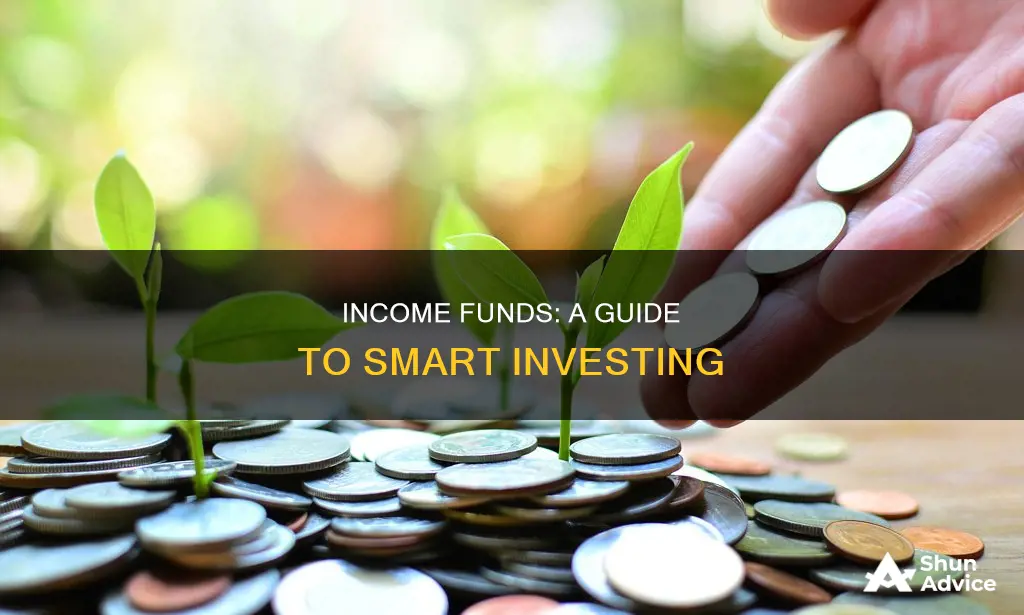
Income funds are a great option for investors looking for regular payouts without having to lift a finger. These funds invest in portfolios of companies that pay consistent dividends, spreading risk across a range of businesses and sectors. While some funds explicitly aim to provide investors with monthly income, others, like property funds, pay out dividends monthly.
When choosing an income fund, investors should consider not just the yield but also the fund's investments. This is because funds that aim for a similar payout each month may be restricted in how they can invest, and there is often a mismatch between their payouts and the income they receive from their assets.
Additionally, investors prioritising high income in the short term may be willing to accept lower total returns, while those seeking to build solid growth over time can reinvest their dividends.
What You'll Learn

Monthly income funds
One example of a monthly income fund is the Schwab Monthly Income Funds, which offer investors a choice between three distinct income strategies. Each fund has a specific monthly payout strategy while also seeking capital appreciation as a secondary objective. The funds are designed to provide income from multiple asset classes within the convenience of a single fund, keeping costs low and with no investment minimum.
Another popular monthly income fund is the Premier Multi-Asset Monthly Income fund, which has an ongoing charge of 1.42% and yields almost 5%. This fund invests in a broad range of assets and has a proven track record of producing excellent results.
When choosing a monthly income fund, it is important to consider not only the yield but also the fund's investment strategy and the types of assets it invests in. For example, the Invesco Perpetual Monthly Income Plus fund yields 5% and primarily invests in bonds, with a small holding in shares. The Artemis Monthly Distribution fund, on the other hand, invests in shares and bonds, focusing on sustainable yield, and currently yields around 3.7%.
It is also worth noting that some funds may use complicated techniques, such as selling derivatives, to boost their income. This can result in lacklustre capital returns, so it is important to carefully research and understand the fund's investment strategy before making a decision.
The Global Investment Hub: Where Funds Call Home
You may want to see also

Holding accounts
Taxable Accounts
Taxable accounts, such as brokerage accounts, offer investors greater flexibility and fewer restrictions compared to tax-advantaged accounts. The returns generated in taxable accounts are taxed based on the duration for which the underlying assets are held. Investments held for over a year are typically subject to long-term capital gains taxes, while shorter-term holdings are taxed according to the investor's ordinary income tax bracket.
Tax-Advantaged Accounts
Tax-advantaged accounts, including traditional IRAs and 401(k)s, provide upfront tax benefits. Taxes are paid only when funds are withdrawn, usually during retirement. Roth IRAs and Roth 401(k)s are a specific type of tax-advantaged account where contributions are made with after-tax dollars, but subsequent investment growth is tax-free. Withdrawals from these accounts during retirement are also tax-free. However, withdrawals before reaching retirement age may trigger restrictions and penalties.
Choosing the Right Holding Account
The choice between taxable and tax-advantaged accounts depends on an investor's specific circumstances and tax bracket. Tax-advantaged accounts are suitable for those seeking to minimise taxes and maximise long-term returns, especially if they are in a higher tax bracket. On the other hand, taxable accounts offer more flexibility and can be used for a broader range of investment objectives.
Additionally, the type of investments made can influence the choice of holding account. Investments that are more tax-efficient, such as municipal bonds, are often placed in taxable accounts, while investments that lose more of their returns to taxes are placed in tax-advantaged accounts.
Life Investment Funds: Your Best Long-Term Investment Option
You may want to see also

Building a portfolio of funds
Darius McDermott of fund shop Chelsea Financial Services notes that most monthly income funds attempt to offer 11 monthly payments of a similar amount and a 12th that varies, depending on the fund's performance.
James Baxter of adviser Tideway highlights the mismatch between the regular payouts from monthly income funds and the income the funds actually receive from the assets they are invested in. This can put pressure on managers to invest in assets that distribute income at set points of the year, rather than those that are most attractive from a growth or income perspective.
Therefore, it is important to choose a fund based on what it is invested in, rather than just looking at the yield figure.
For those who may need the exact same level of income each month, a portfolio of income-paying funds and trusts that give their dividends at different points in the year may not be suitable.
However, for those who prioritise consistent dividend growth, investment trusts can be particularly useful. Their ability to hold back income means many have been able to increase their dividend year-on-year for decades.
| Fund Name |
|---|
| Artemis Monthly Distribution |
| Invesco Perpetual Monthly Income Plus |
| Premier Multi-Asset Monthly Income |
| Rathbone Ethical Bond |
| Artemis Global Income |
| Finsbury Growth & Income |
| Lowland |
| Diverse Income Trust |
Schwab Fund Investment: A Beginner's Guide to Getting Started
You may want to see also

Investment trusts
- Long-term view: The fixed number of shares allows investment trusts to take a long-term view and build a strategy, as they are not affected by unpredictable inflows and outflows of money.
- Diversification: Investment trusts invest in a variety of different companies, often across multiple markets and sectors, which reduces the risk of relying on the performance of just one or two businesses.
- Shareholder rights: When you invest in an investment trust, you become a shareholder with voting rights and the ability to attend the Annual General Meeting (AGM).
- Low costs: Annual charges are paid out of the trust's assets rather than the investor's account, resulting in lower costs for investors.
- Income consistency: Investment trusts can retain up to 15% of their net income each year, allowing them to smooth out payments over the years and maintain consistent dividend payouts.
- Borrowing power: Investment trusts can borrow money (gearing) to potentially boost returns, although this can also magnify losses.
It's important to remember that, like any other investment, investment trusts involve the risk of loss. The value of investments can fall as well as rise, and you may get back less than you invest.
Hayman Capital Master Fund: A Smart Investment Strategy
You may want to see also

Mutual funds
Set Clear Investment Goals
Before investing in mutual funds, it's important to identify your financial goals and time horizon. Are you investing for the short-term or long-term? Do you have a specific target, such as saving for retirement, buying a home, or your child's education? Knowing your goals will help you determine the appropriate investment strategy and types of mutual funds to consider.
Choose the Right Account Type
You can invest in mutual funds through various account types, depending on your goals and preferences. You can open a standard brokerage account, contribute to an employer-sponsored retirement account (e.g., 401(k)), or explore options like traditional IRAs or Roth IRAs for tax-advantaged retirement savings.
Determine Your Asset Allocation
Decide on the right mix of stocks, bonds, and other holdings for your portfolio. This will depend on your risk tolerance, investment horizon, and financial goals. Generally, if you have a longer time horizon, you can allocate a larger portion of your portfolio to stocks, while bonds become more important for conservative investors or those nearing retirement.
Pick an Investment Strategy
You'll need to choose between actively managed funds and passive funds. Actively managed funds employ fund managers who aim to beat the market by actively selecting stocks and bonds. These funds tend to charge higher fees. On the other hand, passive funds aim to match market benchmarks and are typically less expensive.
Research Mutual Fund Companies and Funds
Select a reputable mutual fund company that aligns with your investment goals and strategy. Consider well-known companies like Vanguard or Fidelity, or research smaller firms with strong track records. Once you've chosen a company, study their menu of fund options and compare fees, performance, and investment strategies.
Open an Investment Account
After deciding on the mutual funds you want to invest in, it's time to open an account. You can do this through your chosen mutual fund company or a brokerage platform. Provide the necessary information, such as your Social Security number and date of birth, and follow the platform's instructions.
Purchase Shares of Mutual Funds
Make sure you have enough funds in your investment account to meet the minimum investment requirements of the mutual funds you've selected. Keep in mind that mutual funds may have higher investment minimums than other asset classes. You can then proceed to purchase shares, keeping in mind that mutual funds only trade once per day after the market closes.
Create a Regular Investment Plan
Investing is often a long-term endeavour, and it's essential to establish a plan to invest regularly. Consider setting up recurring investments through your brokerage platform to grow your wealth over time. This can also help you take advantage of dollar-cost averaging, reducing the risk of buying at market highs.
Monitor and Rebalance Your Portfolio
Don't forget to regularly check in on your investments, at least once a year. This will allow you to rebalance your portfolio and ensure it aligns with your risk tolerance and financial goals. Remember that investing in mutual funds requires a long-term perspective, so try not to make impulsive decisions based on short-term market fluctuations.
Understand the Tax Implications
When investing in mutual funds, be mindful of the tax consequences. Mutual funds distribute capital gains and dividends, which may have tax implications. Consult with a tax professional to understand how these distributions may impact your tax liability and to explore strategies for minimising taxes on your investments.
Diversify Your Portfolio: Avoid Single Mutual Fund Investments
You may want to see also
Frequently asked questions
Income funds can provide a regular income without the investor having to lift a finger. They can also be a great way to build solid growth over time as reinvested dividends are a key component of long-term growth.
Some examples of good income funds to invest in include the Standard Life UK Equity Unconstrained fund, the Premier Multi-Asset Monthly Income fund, the Rathbone Ethical Bond fund, and the Artemis Global Income fund.
When choosing an income fund, it's important to consider your individual circumstances and investment goals. It's also crucial to do your own research and choose investments carefully.
Income funds, particularly those focused on specific sectors, can be more volatile and risky than broader-based funds. Additionally, investors may need to sacrifice capital returns to achieve higher income.







